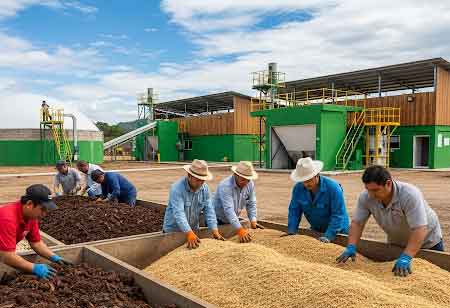Thank you for Subscribing to Agri Business Review Weekly Brief
Latin America's Rise in Agricultural Bioenergy

By
Agri Business Review | Wednesday, November 26, 2025
Stay ahead of the industry with exclusive feature stories on the top companies, expert insights and the latest news delivered straight to your inbox. Subscribe today.
Latin America, a region abundant in agricultural resources, increasingly recognizes the immense potential of converting agricultural waste into renewable energy. This burgeoning sector is driven by a confluence of factors, including a growing demand for energy, the imperative for sustainable waste management, and the desire to reduce reliance on fossil fuels. The sheer volume of agricultural residues generated annually across the continent presents a significant opportunity for bioenergy production, contributing to environmental stewardship and economic development. The financial benefits of these projects, including job creation and revenue generation, make them attractive for investors and policymakers.
The agricultural landscape in Latin America is diverse, encompassing vast plantations of sugarcane, corn, rice, and other staple crops, alongside extensive livestock operations. Each of these activities yields substantial quantities of waste biomass. Sugarcane bagasse, a fibrous residue left after juice extraction, is a particularly prominent feedstock in countries like Brazil, which is a global leader in sugarcane production. Similarly, residues from corn stalks, rice husks, coffee pulp, and animal manure contribute significantly to the agricultural waste stream. Conventionally, much of this waste has been either left to decompose, burned in open fields, or poorly managed in landfills, leading to environmental concerns such as greenhouse gas emissions and water pollution. However, a transformative shift is underway as the region embraces technologies to convert these liabilities into valuable energy assets.
Biochemical and Thermochemical Technologies in Bioenergy
The conversion of agricultural waste into renewable energy in Latin America primarily employs various thermochemical and biochemical technologies. Among these, anaerobic digestion stands out as a widely adopted biochemical process. This technology involves the decomposition of organic matter by microorganisms in the absence of oxygen, producing biogas rich in methane. Biogas can then be used directly for heat and electricity generation, or upgraded to biomethane for vehicle fuel or injection into natural gas grids. The versatility of anaerobic digestion makes it suitable for various agricultural wastes, including animal manure, crop residues, and agro-industrial byproducts. The digestate, a nutrient-rich byproduct of anaerobic digestion, can also be utilized as a biofertilizer, closing the loop in a circular economy approach.
Advances in Thermochemical Conversion Methods
Thermochemical conversion methods also play a crucial role. Direct combustion, while a simpler technology, involves burning agricultural waste to produce heat and steam, which can then drive turbines for electricity generation. This is particularly prevalent in the sugar industry, where bagasse is often co-fired or combusted in dedicated boilers to power sugar mills and supply surplus electricity to the national grid. Gasification is another promising thermochemical process that converts biomass into a combustible gas mixture known as syngas, which can be used to generate electricity or produce biofuels. Conversely, pyrolysis involves heating biomass without oxygen to produce bio-oil, biochar, and syngas, offering a diverse range of energy products. These technologies are increasingly being explored and implemented to extract maximum energy value from agricultural residues.
Policy Support and Future Perspectives
The scale of bioenergy potential from agricultural waste in Latin America is substantial. Projections indicate that agricultural biomass could account for a significant portion of the region's overall bioenergy potential. While hydropower remains a dominant renewable energy source, bioenergy from agrarian waste is steadily gaining ground, contributing to the energy mix and enhanced energy security. The abundance of feedstock, coupled with advancements in conversion technologies, positions the region for continued growth in this sector.
Beyond the technological advancements, the industry's growth is supported by evolving policy frameworks and a growing awareness of sustainability. Governments across Latin America are implementing measures to promote renewable energy and improve waste management practices. These initiatives, which include incentives for bioenergy projects, targets for renewable energy penetration, and regulations aimed at reducing agricultural waste disposal in landfills, provide a reassuring backdrop for the industry's development and expansion.
Furthermore, integrating digital technologies and smart waste management solutions is an emerging trend within the industry. Data analytics and real-time monitoring are being utilized to optimize waste collection, transport, and processing, enhancing bioenergy projects' efficiency and economic viability. The focus is not just on converting waste to energy, but also on creating value chains that minimize resource loss and maximize sustainable outcomes. This includes efforts to improve feedstock quality through better sorting and pre-treatment, which enhances conversion technologies' performance.
The ongoing development in agricultural waste-to-energy solutions in Latin America points towards a future where waste is increasingly viewed as a valuable resource. The continuous innovation in processing technologies, coupled with supportive policy environments and a growing emphasis on circular economy principles, is driving the transformation of agricultural residues into a significant and sustainable energy source for the region. This trajectory not only bolsters energy independence and contributes to a more sustainable and resilient energy landscape across Latin America but also holds the promise of creating green jobs, thereby enhancing the industry's social impact.





